Flinders Island (South Australia) facts for kids
| Geography | |
|---|---|
| Location | Great Australian Bight |
| Coordinates | 33°42′49″S 134°29′49″E / 33.71367°S 134.49686°E |
| Area | 3,642 ha (9,000 acres) |
| Highest elevation | 66 m (217 ft) |
| Administration | |
|
Australia
|
|
Flinders Island is a special island located in the Investigator Group. It sits off the coast of South Australia, about 32 kilometers (20 miles) west of the town Elliston.
The island got its name from Matthew Flinders in 1802. He named it after his younger brother, Samuel Flinders. Samuel was a second lieutenant on Matthew's ship, the HMS Investigator.
Flinders Island is part of an important area for birds. It is called the Investigator Islands Important Bird Area. The island is home to a group of little penguins. However, wild animals like feral cats, black rats, and mice have caused problems. These animals threaten the native birds.
The island is privately owned. For many years, since 1911, it was mainly used for farming. But farming became less common as it got too expensive to transport goods. In 2020, the owners made a deal with the Government of South Australia. This agreement protects most of the island, about 3,400 hectares (8,400 acres), for conservation.
People have also looked for diamonds on Flinders Island. They found signs of minerals that often appear with diamonds. This search was still happening in 2019.
Contents
Island History
European Discovery and Early Use
Matthew Flinders named Flinders Island on February 13, 1802. He named it after his younger brother, Samuel. Samuel was a second lieutenant on Flinders' ship, the Investigator.
Flinders' team wrote about the plants and animals they saw. They noted that the lower parts of the island had large bushes. This was different from other islands they had seen. They also saw very little of the common white grass.
They found many small macropods, which are like kangaroos or wallabies. They also saw a few small casuarina trees. But finding firewood was hard. The beaches were often visited by Australian sea lions. Flinders' crew watched several groups of these sea lions closely.
Sealing and Whaling Activities
By the 1820s, people had set up a camp on the island. This camp was for hunting seals. There was also a station for whaling, which is hunting whales. At one point, about twenty people lived there. This included sealers, their Aboriginal wives, and children.
In 1890, a survey found ten old buildings from the sealing community. Later, in the 1980s, experts studied these old structures. The place where sealing and whaling happened on Flinders Island is now protected. It is listed on the South Australian Heritage Register.
Farming and Ownership Changes
Before 1911, people brought sheep, horses, and cattle to Flinders Island. They also planted crops like milk thistles and oats. About 1,500 acres (600 hectares) of the island were cleared for farming. This land produced a lot of wheat each year.
Around 4,000 sheep were kept on the island. Wild black and white rabbits also lived there. By 1911, when the island was sold, 30,000 wallabies had been hunted.
Farming continued to be the main activity for many years. However, it became less profitable as transport costs increased. In the late 1970s, the Woolford family bought the island. They raised merino sheep there. By 2020, there were only a few sheep left. The island was mostly used for tourism, with people renting houses, and for recreation.
Protecting the Island's Nature
Important Bird Area
Flinders Island is part of the Investigator Islands Important Bird Area. This special status was given in 2009. It recognizes the island group's importance for birds.
The area is home to a population of fairy terns, which are a vulnerable species. It also has many Cape Barren geese, Pacific gulls, and black-faced cormorants. Many short-tailed shearwaters and white-faced storm-petrels also breed here. The rock parrot, a bird found only in certain areas, has been seen on most islands in the group.
Protecting Little Penguins
In 1934, a report mentioned that penguins could be seen walking among the rocks on Flinders Island. By 2006, there was a group of little penguins on the island. Their numbers were thought to be decreasing. There were fewer than twenty birds, nesting near cliffs. Wild cats had limited access to these areas.
In 2016, a study looked at the risks for the penguins. It suggested that wild cats were causing the penguin numbers to drop. But if the cats were removed, the rat population might grow. So, both cats and rats would need to be removed to help the penguins.
Conservation Agreements
A strip of land along the north coast of the island has been protected since 1995. This area, about 279 hectares (690 acres), is part of a heritage agreement. Since 2012, the waters around Flinders Island have also been protected. They are part of a special habitat zone in the Investigator Marine Park.
In 2020, the island's owners signed an important agreement. This deal with the Government of South Australia protects about 3,400 hectares (8,400 acres) of the island. This is most of the island's land.
The plan is to get rid of the wild cats, black rats, and mice. These animals threaten the native birds. Once these pests are gone, threatened native animals can be brought back to the island. This project is called the Flinders Island Safe Haven Project. It received 1.67 million Australian dollars from the Federal Government. The Government of South Australia also gave 1 million Australian dollars. They are working with the Woolford family to manage this important project.
Diamond Exploration
People have been exploring Flinders Island for diamonds. They found different types of minerals there that often point to diamonds. This search for diamonds was still going on in 2019.


